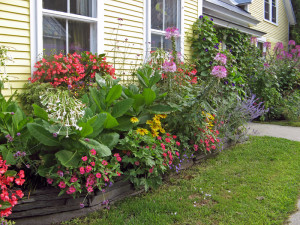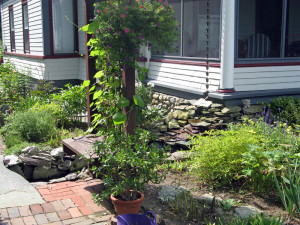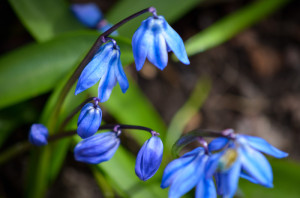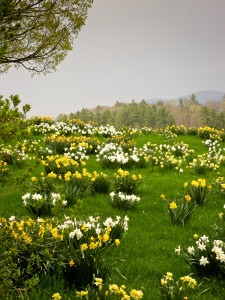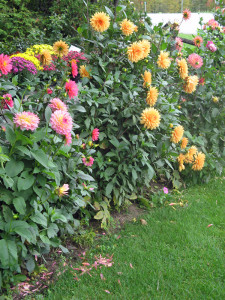Gift to the neighborhood
For most of us, our gardening takes place out of the public eye. We want to enjoy our gardens in peace and quiet, which usually means we devote the lion’s share of our gardening efforts to the ‘back garden’. Indeed garden writers, sensing our desire to retreat from the hustle and bustle of the world, have written extensively about the idea of creating ‘garden sanctuaries‘.
So it takes a very special person indeed to lavish their care and attention on a roadside garden, where the pleasure will be shared with all who pass by.
We’ve all seen these special gardens– a gorgeous flower-filled border abutting the sidewalk, a beautiful expanse of spring bulbs, or an enchanting side garden hidden in plain sight. Each time I see one it sends tingle of pleasure down my spine and puts smile on my face. They are indeed
Gifts to the neighborhood.
For some time now I have been capturing some of these singular gardens in pictures; here are some of my favorites Think of this posting as a salute to those who spread the pleasure of beauty around our communities. And along the way I have included a few tips for other gardeners to emulate.
A Rochester gem
Many a time, when coming down the hill from the east into the little town of Rochester (Vermont), I slow to a crawl so that I can savor one of my favorite gardens.
Even including the narrow stretch of lawn, at its widest it probably measures no more than ten feet between the house and the sidewalk. This tiny garden, like a perfect jewel, adorns a neat yellow clapboard house with white trim and a bright blue front door. Filled with colorful flowers the garden is always meticulously tidy and a joy to behold.
It is the perfect gift to the neighborhood.
I have been observing this garden for many years now, stopping more than once to take pictures. Finally, for the first time, this year I met the gardener, Kathryn Schenkman. I was driving home from Randolph, one valley further east, and there she was, out doing her spring planting. I parked the car and hurried back to say hello. What a delight to be able to meet her in person and to tell her how much joy her special garden has given me over the years.
What makes it so special?
First, with plenty of annuals in the mix, this little garden stays full and lush from spring until fall.
And, while Kathryn changes the combination of flowers from year to year, she chooses colors that will co-ordinate beautifully with the cheery yellow siding and the bright blue front-door. She told me she has the help of a friend, Rachel Seymour, as she plans each year’s unique combination.
Finally, although this garden is small, it is no shrinking violet. Kathryn always incorporates some big and bold flowers, such as some tall pink spider flowers, Cleome hassleriana, white fragrant flowering tobacco, Nicotiana sylverstris, and deep blue morning glories, Ipomoea tricolor. She repeats these tall plants at intervals down the entire length, and on either side of the front-door, a technique which serves to integrate the whole design. And the bigger plants in the design are tall enough to reach up as high as the window boxes, ensuring that these too will be pulled into the picture.
Brandon postcard
Park Street in Brandon is a visitor’s dream-come-true. Just a stone’s throw from the central town green, this wide boulevard boasts a generous sidewalk and many splendid Victorian-era houses with immaculate front gardens.
Brandon was laid out over 150 years ago with the axis of Park Street pointing directly to the Congregational church in the west. The church spire, visible along the entire length of the street and framed by stately maple trees, is like a finger pointing to the sky.
Brandon is also our closest place for shopping and we enter town along Park Street. How I love to watch the people, often with kids and dogs in tow, stroll along the sidewalk enjoying each others company. And as a gardener I also have eyes for the evolving Park Street gardens, as they progress from season to season, and from year to year.
A side yard transfigured
For the past few years I have been watching as the owners of the immaculate house next to the library gradually transform the narrow strip of land between themselves and the house next door. The result is a small and beautiful side garden, visible to Park Street pedestrians and slow drivers alike ….and certainly another gift to the neighborhood!
.
 As I drove by one beautiful sunny day in early September I spied the owner, Pamela Gatos, busy freshening up the garden for autumn, and replacing some spent flowers with cheery chrysanthemums ready to greet the fall visitors. So I stopped my car to introduce myself and say hello.
As I drove by one beautiful sunny day in early September I spied the owner, Pamela Gatos, busy freshening up the garden for autumn, and replacing some spent flowers with cheery chrysanthemums ready to greet the fall visitors. So I stopped my car to introduce myself and say hello.
Typically the side-yards of in-town houses are narrow, somewhat shady and dominated by the path to the back garden. So oftentimes homeowners feel it is just not worth the effort to develop this area.
But Pamela and her husband have eliminated all the lawn in their side yard and filled it with flowering plants and shrubs on either side of the path.
They defined the garden’s entrance with an arbor, clad with morning-glories and hung with colorful hanging baskets. This serves to create a subtle but important psychological demarcation between the public sidewalk and their personal space behind. The result is an charming look-into garden, with just a hint of their back garden discernible beyond.
I was also intrigued with their use of a rainchain to direct water from the roof into a small rock-lined pool set just behind the arbor and spanning both sides of the path. A flat stone acts as a small bridge and a recirculating pump feeds a small waterfall by the house—a soothing element for a town garden.
.
The excitement of spring
Spring, which comes in late April and May in this part of the country, is always a time of optimism, as we plan and devise our summer gardens.
But to make a spring garden we need to look a little further ahead. It’s still not too late to plant some daffodils where their flowers will gladden the hearts of all who passes the house.
Or better yet, next spring, after some of your exiting daffodils have finished flowering but while they still have their green foliage, move some to a new spot. Bulbs gradually expand and eventually a clump will become so crowded that the individual bulbs are unable to reach full size. This in turn reduces the number of flowers they produce. So from time to time it is beneficial to dig up the entire clump, then separate and replant the individual bulbs in a new location.
And while you are at it plant a few along the road for the pleasure of all who pass by.
Spring blue carpet
Each spring I take pleasure in another simple gift to Brandon’s neighborhood—a child’s swing beside an old maple tree surrounded by an amazing carpet of blue.
It is Scilla siberica or Blue Squill. Olya and Seth Hopkins—owners of the big yellow house on Park Street—tell me that they were not responsible for actually planting the original bulbs. But each year, by simply resisting the impulse to get out too early with the lawn mower and by leaving the spent foliage until it has turned yellow, they have surely helped the patch become the beautiful display it is today.
Left to their own devices Scilla will naturalize around the place and, since they spread by seed, over the years even a small patch will gradually expand. It is interesting to note how Seth and Olya’s patch has migrated across a driveway into the neighbor’s lawn.
.
.
A host of golden daffodils
For another visual treat every year I drive out west from Brandon to take in the breathtaking sight of a hillside field of daffodils.
Providing they have enough sun, daffodils will compete very well with the grasses in a meadow which is mown once or twice a year.
However this beauty comes at a price—-since daffodils are poisonous to livestock the owners of the farm (whom I have never met) presumably must avoid using the field (at least as long as the foliage is above ground) for any of their animals.
I do something a little different with my daffodils. Each year I transplant a few mature clumps under the birches that separate our garden from the road, where they are naturalizing nicely. I hope they bring pleasure both to my neighbors and and to the occasional hikers and bikers who pass by the house.
Business Pleasures
Some of the best ‘gifts to the neighborhood’ are given to us by local businesses. While designed to catch the eyes of potential customers, these roadside give pleasure to all who pass by; and home gardeners can surely learn a thing or two from them.
Here are a couple of examples:
Dahlias: the gift that keep on giving
Pinewood Garden Center, owned by Tom and Bev Sabatini, is situated on a busy stretch of Route 7 just south of Brandon. And even at 50 mph drivers can’t miss the beautiful dahlia display along their split rail fence. A nice invitation to stop in for sure, and certainly a lovely gift to the neighborhood.
Dahlias are warm season perennials that originated in Mexico and over the years plantsmen have hybridized the stunning array of colors and shapes we see today. Since dahlias are perennials they will return year after year, but cold climate gardeners must lift the roots (fleshy tubers) and store them in a cool spot where they won’t freeze.
But unlike most perennials dahlias bloom for months on end, rewarding you with beautiful flowers from July until frost.
Window dressing
This display outside a small clothing store in Lenox, Massachusetts, brings a whole new meaning to term ‘window dressing‘.
As in Kathryn Schenkman’s lovely Rochester garden, it contains an eclectic mix of annuals which bring a vibrancy and energy all season long.
Both gardens look great from a distance. And then as you come closer you get to appreciate the glorious mix of colors and textures employed by these talented garden makers. And in both cases, for an even great impact, window boxes continue the display right up to eye height.
Who could resist stopping to take a closer look??

